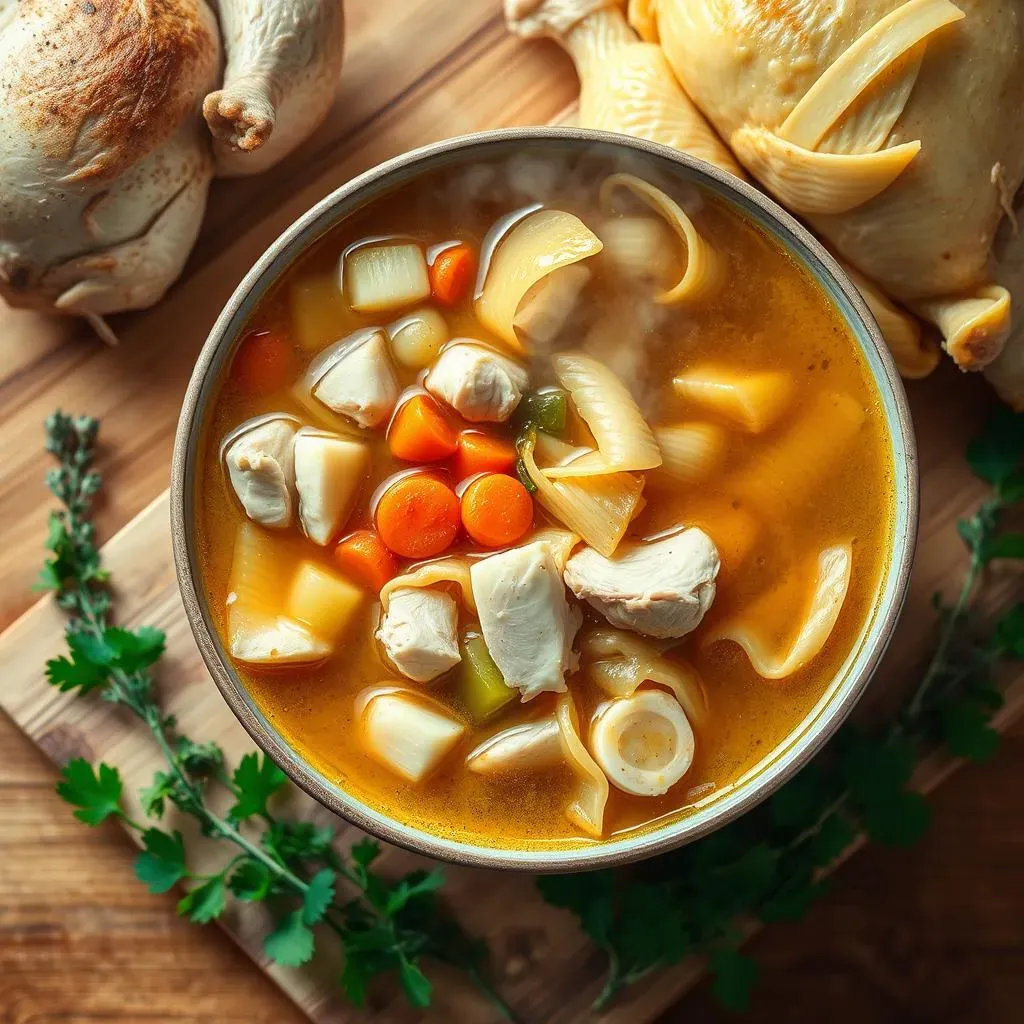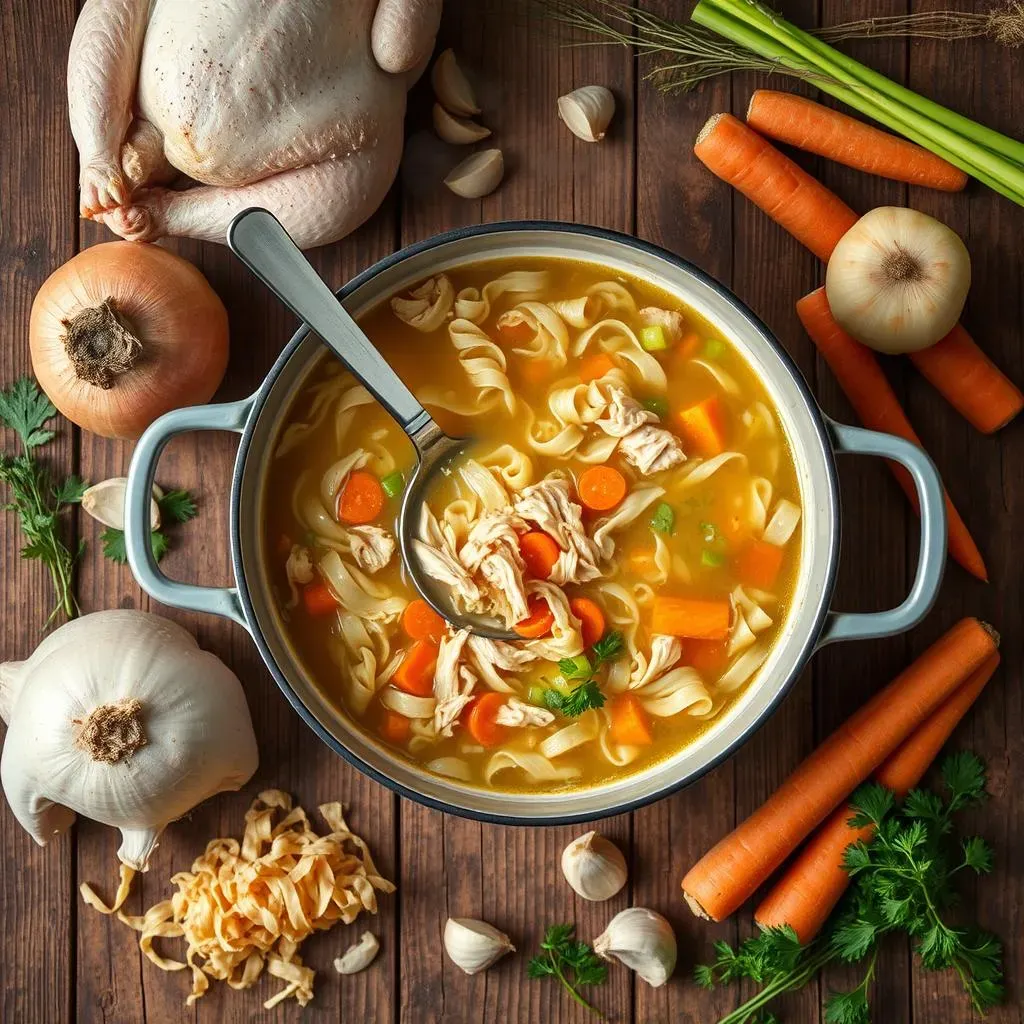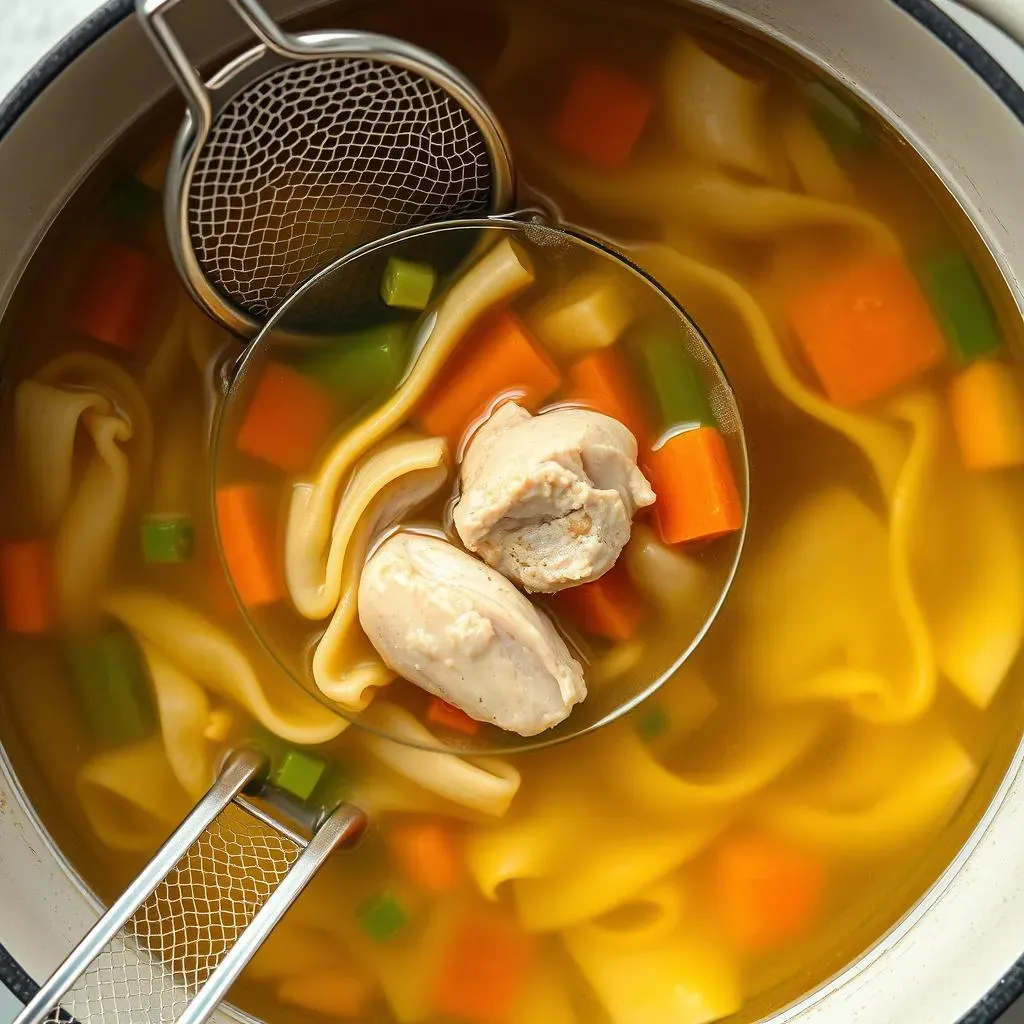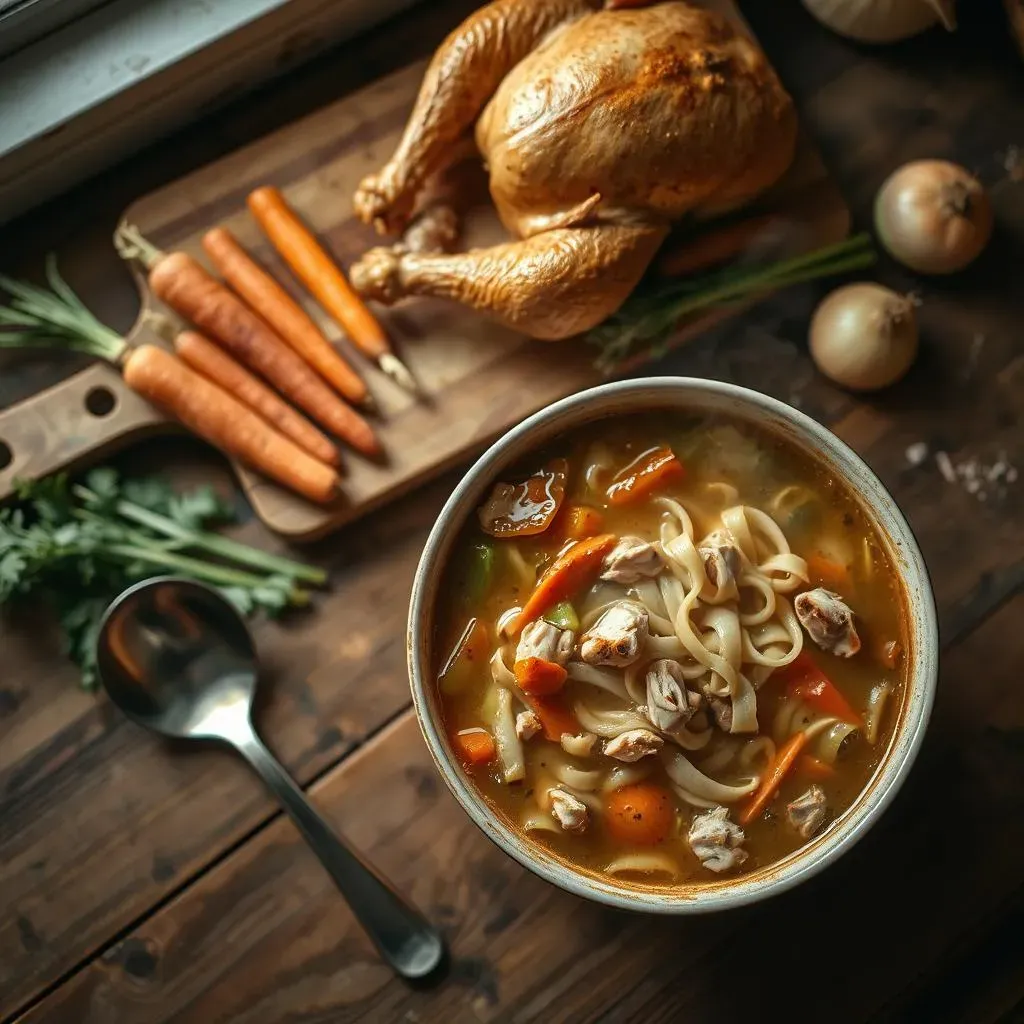Table of Contents
Craving a bowl of pure comfort? Nothing beats a steaming, fragrant bowl of homemade chicken noodle soup. But forget the store-bought stock and pre-cut chicken – we're going back to basics. This chicken noodle soup recipe made with whole chicken is the real deal, the kind your grandma used to make. We're talking about a deeply flavorful broth, tender shredded chicken, and perfectly cooked noodles, all simmered to perfection. This isn't just a recipe; it's an experience. We'll walk you through every step, from selecting the perfect chicken to achieving a crystal-clear broth. Get ready to discover why starting with a whole chicken elevates this classic soup to a whole new level. We'll also share tips for using every last bit of that delicious chicken, so nothing goes to waste. So, grab your stockpot and let's get cooking!
Why Whole Chicken Makes the Best Chicken Noodle Soup

Why Whole Chicken Makes the Best Chicken Noodle Soup
The Flavor Foundation: Building a Superior Broth
Let's be real, the heart of any great chicken noodle soup is the broth. And that's where using a whole chicken truly shines. When you simmer a whole chicken – bones, skin, and all – you're extracting every ounce of flavor and goodness. It's not just about the chicken-y taste; it's about the depth, the richness, and the subtle nuances that you simply can't get from pre-cut pieces or store-bought broth. The bones release collagen, which creates a silky, luxurious texture, while the skin adds a layer of savory flavor that's just irresistible.
Think of it like this: you're building a flavor foundation from the ground up. It's like comparing a house built on solid bedrock to one built on sand. The whole chicken provides that bedrock, that stable and flavorful base that elevates the entire soup. Plus, you get the benefit of both white and dark meat, each contributing its unique texture and taste to the final product. It's a win-win!
Broth Source | Flavor Profile | Texture |
|---|---|---|
Whole Chicken | Deep, complex, rich | Silky, luxurious |
Pre-cut Chicken Pieces | Good, but less complex | Thinner |
Store-Bought Broth | Often bland, can be salty | Watery |
Economical and Versatile: Getting the Most Out of Your Bird
Beyond the superior flavor, using a whole chicken is surprisingly economical. Often, you can find whole chickens on sale for less per pound than individual chicken breasts or thighs. You're not just getting the meat for the soup; you're also getting the bones for the broth, which is essentially a "free" bonus. It's a budget-friendly way to create a truly gourmet soup.
And let's not forget about versatility! After you've simmered your chicken and made your broth, you're left with a generous amount of cooked chicken meat. While some goes into the soup, you can use the rest for chicken salad, tacos, sandwiches, or any other dish that calls for cooked chicken. It's like getting multiple meals out of one ingredient, making it a smart and efficient choice for busy weeknights.
StepbyStep: Crafting Chicken Noodle Soup from a Whole Chicken

StepbyStep: Crafting Chicken Noodle Soup from a Whole Chicken
The Broth is Boss: Simmering Your Way to Flavor
Alright, let's get down to business. First things first, grab a large stockpot – the bigger, the better. Place your whole chicken inside and cover it with about 8-10 cups of cold water. Now, this is where the magic starts. Add in your aromatics: a roughly chopped onion, a couple of carrots (also roughly chopped), a few celery stalks, a few cloves of garlic (smashed), a bay leaf or two, and some sprigs of fresh thyme and parsley. Don't be shy – these veggies and herbs are going to infuse the broth with incredible flavor.
Bring the water to a boil, then immediately reduce the heat to a gentle simmer. This is crucial! A rolling boil will make your broth cloudy, and we want a clear, golden elixir. Skim off any scum that rises to the surface – that's just impurities that you don't want in your final product. Let it simmer, uncovered, for at least 2-3 hours, or even longer if you have the time. The longer it simmers, the richer and more flavorful the broth will become. Trust me, patience is key here.
- Pro Tip: For an even richer flavor, roast the chicken in the oven at 400°F for 30 minutes before simmering.
- Pro Tip: Don't add salt at the beginning. Wait until the end, after the broth has simmered, to season it to taste.
From Chicken to Soup: Shredding, Sautéing, and Simmering Again
Once your chicken is cooked through and practically falling off the bone, carefully remove it from the pot and set it aside to cool slightly. Strain the broth through a fine-mesh sieve or cheesecloth to remove all the solids. This is another key step for achieving a clear broth. Discard the vegetables and herbs – they've done their job!
While the chicken is cooling, sauté some fresh diced carrots, celery, and onion in a little butter or olive oil in the same stockpot. Cook them until they're softened but not browned – about 5-7 minutes. This adds another layer of flavor to the soup. Once the chicken is cool enough to handle, shred the meat, discarding the skin and bones. Add the shredded chicken and the strained broth back to the pot with the sautéed vegetables. Bring to a simmer and add your favorite noodles. Cook until the noodles are tender, and then season with salt, pepper, and any other herbs you like. Taste and adjust the seasonings as needed. And that's it – you've created a masterpiece!
Step | Description | Why It Matters |
|---|---|---|
Simmering Broth | Gently simmer whole chicken with aromatics for 2-3 hours. | Extracts maximum flavor and collagen for a rich, silky broth. |
Straining Broth | Strain broth through a fine-mesh sieve or cheesecloth. | Removes solids for a clear, clean-tasting broth. |
Sautéing Vegetables | Sauté diced carrots, celery, and onion in butter or olive oil. | Adds another layer of flavor and sweetness to the soup. |
Tips & Tricks for a Clear Broth and Perfect Chicken Noodle Soup

Tips & Tricks for a Clear Broth and Perfect Chicken Noodle Soup
The Secret to a Crystal-Clear Broth: Patience and Precision
let's talk clarity. Nobody wants a murky, cloudy broth. The key to achieving that coveted crystal-clear liquid is all about technique. First and foremost, maintain a gentle simmer – no rolling boils allowed! As we mentioned before, a vigorous boil will agitate the impurities and cloud up your broth. Secondly, be diligent about skimming. Use a fine-mesh skimmer to remove any scum or foam that rises to the surface during the simmering process. This is where all those impurities are hiding, and removing them will make a world of difference.
Another trick is to avoid browning your vegetables when you sauté them. Browning adds a deeper flavor, which can be great in some soups, but it can also darken the broth. Aim for softened and translucent, not caramelized. And finally, resist the urge to stir the soup too much while the noodles are cooking. Stirring releases starch, which can also cloud the broth. A gentle stir every now and then is all you need.
- Simmer Gently: Avoid a rolling boil.
- Skim Diligently: Remove scum and foam regularly.
- Don't Brown Veggies: Sauté until softened, not browned.
- Stir Sparingly: Avoid excessive stirring while cooking noodles.
Noodle Nirvana: Choosing the Right Pasta
The type of noodle you use can make or break your chicken noodle soup experience. Some folks swear by egg noodles, while others prefer smaller pasta shapes like ditalini or orzo. Ultimately, it comes down to personal preference, but there are a few things to keep in mind. Egg noodles are classic and provide a nice, chewy texture. However, they can also absorb a lot of liquid, so you may need to add more broth as they cook. Smaller pasta shapes cook quickly and are great for kids (and adults who prefer a more delicate texture). Just be careful not to overcook them, or they'll turn to mush.
If you're using long pasta like spaghetti or fettuccine, break it into smaller pieces before adding it to the soup. This makes it easier to eat and prevents those awkward, dangling noodle moments. And whatever you do, don't add the noodles to the soup until the very end, just before serving. Overcooked noodles are the enemy of good soup! A good strategy is to cook the noodles al dente separately and add them to the soup when serving.
Noodle Type | Texture | Considerations |
|---|---|---|
Egg Noodles | Chewy, substantial | Absorb liquid, cook until al dente |
Ditalini/Orzo | Delicate, small | Cook quickly, watch carefully to avoid overcooking |
Spaghetti/Fettuccine | Firm, long | Break into smaller pieces before adding |
Flavor Boosters: Taking Your Soup to the Next Level
Sometimes, even with the best ingredients and techniques, your soup might need a little extra oomph. That's where flavor boosters come in. One of my favorite tricks is to add a pinch of Vegeta (or another stock powder/bouillon) to the soup. It's basically concentrated umami, and it can really enhance the savory flavor. Just be careful not to add too much, or it can become overpowering. Another great option is a splash of lemon juice or apple cider vinegar. The acidity brightens up the flavors and adds a subtle tang.
And don't forget about fresh herbs! A sprinkle of chopped parsley, dill, or chives at the end adds a burst of freshness and aroma. If you're feeling adventurous, try adding a pinch of red pepper flakes for a touch of heat. Or a dash of Worcestershire sauce for added depth. Experiment and find what works best for your taste buds. The most important thing is to taste and adjust the seasonings as you go, until you achieve the perfect balance of flavors.
Beyond Soup: Using Leftover Chicken Wisely

Beyond Soup: Using Leftover Chicken Wisely
Creative Chicken Transformations: From Soup Star to Culinary All-Star
so you've got a pot of amazing chicken noodle soup, but you're also staring at a pile of leftover shredded chicken. Don't let it languish in the fridge! This is where your culinary creativity can really shine. That leftover chicken is a blank canvas, ready to be transformed into a whole new cast of delicious dishes. Think beyond the basic chicken salad sandwich (though, let's be honest, a good chicken salad is never a bad idea). We're talking tacos, enchiladas, pot pies, even pasta dishes. The possibilities are truly endless!
One of my favorite ways to use leftover chicken is in tacos. Just toss the shredded chicken with some taco seasoning, pile it into warm tortillas with your favorite toppings (salsa, guacamole, sour cream, cheese – the works!), and you've got a quick and easy weeknight meal. Another great option is chicken enchiladas. Roll the chicken up in tortillas with some cheese and enchilada sauce, bake until bubbly, and you've got a crowd-pleasing comfort food classic. And if you're looking for something a little more sophisticated, try adding the chicken to a creamy pasta sauce with some vegetables and herbs. It's a simple way to elevate a basic pasta dish into something truly special.
- Chicken Salad Reinvented: Add grapes, cranberries, or curry powder for a twist.
- Taco Fiesta: Season with taco seasoning and load up on toppings.
- Enchilada Extravaganza: Roll with cheese and enchilada sauce, bake until bubbly.
- Pasta Perfection: Toss with a creamy sauce, vegetables, and herbs.
Storage Savvy: Keeping Your Chicken Fresh and Flavorful
Of course, before you can transform your leftover chicken into culinary masterpieces, you need to store it properly. The key to keeping cooked chicken fresh and flavorful is to cool it down quickly and store it in an airtight container in the refrigerator. According to the USDA, cooked chicken is safe to eat for 3-4 days when stored properly. So, don't let it sit out at room temperature for more than two hours.
If you're not planning on using the chicken within a few days, you can also freeze it. To freeze cooked chicken, wrap it tightly in plastic wrap or freezer paper, or store it in a freezer-safe container. Frozen chicken can last for up to 2-3 months without losing too much quality. When you're ready to use it, thaw it in the refrigerator overnight or in the microwave using the defrost setting. Just be sure to use it immediately after thawing.
Here's a quick guide to storing leftover chicken:
- Cool Quickly: Don't let it sit at room temperature for more than two hours.
- Airtight Container: Store in an airtight container in the refrigerator.
- Eat Within 3-4 Days: Cooked chicken is safe to eat for 3-4 days when stored properly.
- Freeze for Longer Storage: Wrap tightly and freeze for up to 2-3 months.
The Last Word on Homemade Chicken Noodle Soup
So there you have it – a classic chicken noodle soup recipe made with whole chicken that's guaranteed to warm you from the inside out. From the rich, golden broth to the tender chicken and perfectly cooked noodles, every spoonful is a taste of home. Don't be intimidated by the "from scratch" approach; it's simpler than you think, and the flavor payoff is huge. Now, go forth and simmer, and don't forget to share the love (and maybe a bowl or two) with your favorite people!
